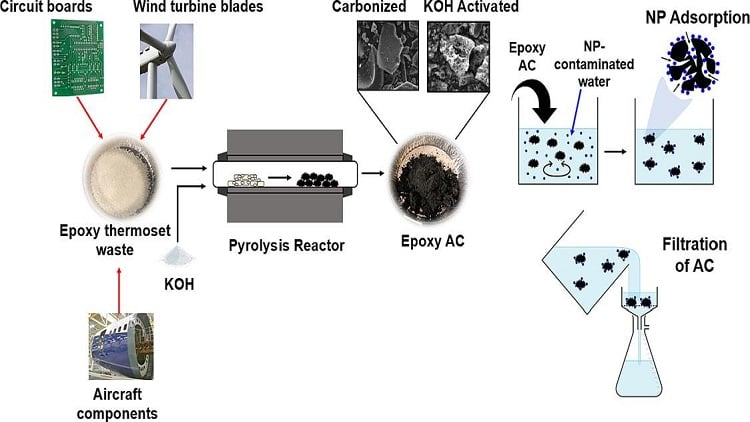S. Himmelstein | May 01, 2024
 Schematic of the epoxy waste-based activated carbon adsorption process. Source: Sep. Purif. Technol. (2023). DOI: 10.1016/j.seppur.2023.124755
Schematic of the epoxy waste-based activated carbon adsorption process. Source: Sep. Purif. Technol. (2023). DOI: 10.1016/j.seppur.2023.124755
The ubiquitous nature of nanoplastics in aquatic systems poses threats to the environment and human health. Conventional water and wastewater treatment systems have proven either inefficient in capturing these contaminants or too costly to implement. An efficient and cost-effective means of removing nanoplastics has been devised by University of Waterloo, Canada, researchers. The clever cannibalistic treatment scheme uses waste plastic to prey upon the microplastics present in water.
The process relies on the use of activated carbons derived from epoxy waste, providing a means to treat wastewater as well as an alternative disposal route for waste thermoset plastic. Instead of ending up in landfills, the material is subjected to thermal decomposition for conversion into a high surface area activated carbon, a material capable of removing nanoplastics.
The epoxy-based activated carbon was applied to the treatment of water contaminated by the production of nanoplastics from polyethylene terephthalate, a form of polyester commonly used in plastic water bottles and clothing. A 94% removal efficiency was achieved by physically trapping the constituents of interest in the porous structure of the waste-derived activated carbon.
Future efforts will test the approach described in the journal Separation and Purification Technology with other types of plastics and scale-up evaluations in municipal wastewater treatment facilities.
INDUSTRY RELATED
UNLIMITED FREE ACCESS TO THE WORLD’S BEST IDEAS
SIGN UP TO SEE MORE
This is embarrasing…
An error occurred while processing the form. Please try again in a few minutes.
Customize Your GlobalSpec Experience
This is embarrasing…
An error occurred while processing the form. Please try again in a few minutes.
